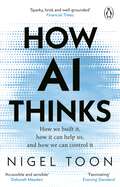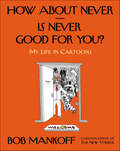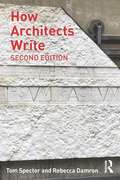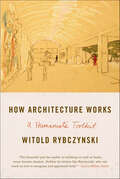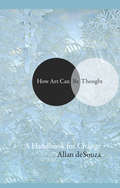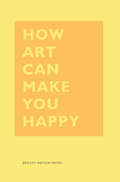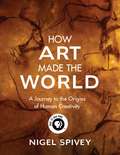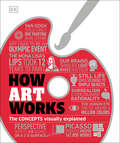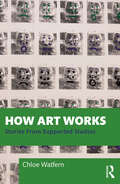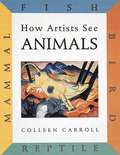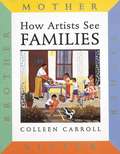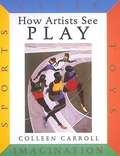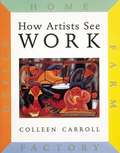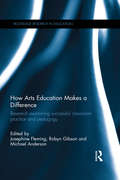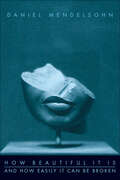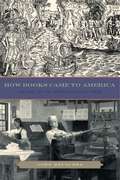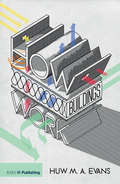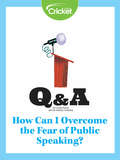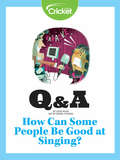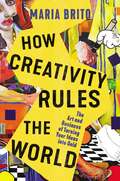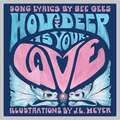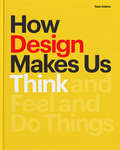- Table View
- List View
How AI Thinks: How we built it, how it can help us, and how we can control it
by Nigel ToonTHE #2 TIMES BESTSELLER'Artificial intelligence is going to have a massive impact on everyone’s lives... an accessible and sensible read that helps demystify AI' Deborah Meaden, entrepreneur and star of Dragon's Den'Nigel Toon is a visionary leader in the field of artificial intelligence... a must-read' Marc Tremblay, Distinguished Engineer, MicrosoftThose who understand how AI thinks are about to win big.We are used to thinking of computers as being a step up from calculators - very good at storing information, and maybe even at playing a logical game like chess. But up to now they haven't been able to think in ways that are intuitive, or respond to questions as a human might. All that has changed, dramatically, in the past few years.Our search engines are becoming answer engines. Artificial intelligence is already revolutionising sectors from education to healthcare to the creative arts. But how does an AI understand sentiment or context? How does it play and win games that have an almost infinite number of moves? And how can we work with AI to produce insights and innovations that are beyond human capacity, from writing code in an instant to unfolding the elaborate 3D puzzles of proteins?We stand at the brink of a historic change that will disrupt society and at the same time create enormous opportunities for those who understand how AI thinks. Nigel Toon shows how we train AI to train itself, so that it can paint images that have never existed before or converse in any language. In doing so he reveals the strange and fascinating ways that humans think, too, as we learn how to live in a world shared by machine intelligences of our own creation.
How About Never—Is Never Good for You?: My Life in Cartoons
by Bob MankoffMemoir in cartoons by the longtime cartoon editor of The New YorkerPeople tell Bob Mankoff that as the cartoon editor of The New Yorker he has the best job in the world. Never one to beat around the bush, he explains to us, in the opening of this singular, delightfully eccentric book, that because he is also a cartoonist at the magazine he actually has two of the best jobs in the world. With the help of myriad images and his funniest, most beloved cartoons, he traces his love of the craft all the way back to his childhood, when he started doing funny drawings at the age of eight. After meeting his mother, we follow his unlikely stints as a high-school basketball star, draft dodger, and sociology grad student. Though Mankoff abandoned the study of psychology in the seventies to become a cartoonist, he recently realized that the field he abandoned could help him better understand the field he was in, and here he takes up the psychology of cartooning, analyzing why some cartoons make us laugh and others don't. He allows us into the hallowed halls of The New Yorker to show us the soup-to-nuts process of cartoon creation, giving us a detailed look not only at his own work, but that of the other talented cartoonists who keep us laughing week after week. For desert, he reveals the secrets to winning the magazine's caption contest. Throughout How About Never--Is Never Good for You?, we see his commitment to the motto "Anything worth saying is worth saying funny."
How Architects Write
by Rebecca Damron Tom SpectorHow Architects Write shows you the interdependence of writing and design in both student and professional examples. This fully updated edition features more than 50 color images, a new chapter on online communication, and sections on critical reading, responding to requests for proposals, the design essay, storyboarding, and much more. It also includes resources for how to write history term papers, project descriptions, theses, proposals, research reports, specifications, field reports, client communications, post-occupancy evaluations, and emailed meeting agendas, so that you can navigate your career from school to professional practice.
How Architecture Works: A Humanist's Toolkit
by Witold RybczynskiAn essential toolkit for understanding architecture as both art form and the setting for our everyday livesWe spend most of our days and nights in buildings, living and working and sometimes playing. Buildings often overawe us with their beauty. Architecture is both setting for our everyday lives and public art form—but it remains mysterious to most of us. In How Architecture Works, Witold Rybczynski, one of our best, most stylish critics and winner of the Vincent Scully Prize for his architectural writing, answers our most fundamental questions about how good—and not-so-good—buildings are designed and constructed. Introducing the reader to the rich and varied world of modern architecture, he takes us behind the scenes, revealing how architects as different as Frank Gehry, Renzo Piano, and Robert A. M. Stern envision and create their designs. He teaches us how to "read" plans, how buildings respond to their settings, and how the smallest detail—of a stair balustrade, for instance—can convey an architect's vision. Ranging widely from a war memorial in London to an opera house in St. Petersburg, from the National Museum of African American History and Culture in Washington, D.C., to a famous architect's private retreat in downtown Princeton, How Architecture Works, explains the central elements that make up good building design. It is an enlightening humanist's toolkit for thinking about the built environment and seeing it afresh. "Architecture, if it is any good, speaks to all of us," Rybczynski writes. This revelatory book is his grand tour of architecture today.
How Art Can Be Thought: A Handbook for Change
by Allan DeSouzaWhat terms do we use to describe and evaluate art, and how do we judge if art is good, and if it is for the social good? In How Art Can Be Thought Allan deSouza investigates such questions and the popular terminology through which art is discussed, valued, and taught. Adapting art viewing to contemporary demands within a rapidly changing world, deSouza outlines how art functions as politicized culture within a global industry. In addition to offering new pedagogical strategies for MFA programs and the training of artists, he provides an extensive analytical glossary of some of the most common terms used to discuss art while focusing on their current and changing usage. He also shows how these terms may be crafted to new artistic and social practices, particularly in what it means to decolonize the places of display and learning. DeSouza's work will be invaluable to the casual gallery visitor and the arts professional alike, to all those who regularly look at, think about, and make art—especially art students and faculty, artists, art critics, and curators.
How Art Can Make You Happy (The HOW Series)
by Bridget Watson PayneWhy is art magical? How can it make us happy? How Art Can Make You Happy offers the keys to unlocking a rich and rewarding source of joy in life. This easy, breezy handbook is full of insight that will help regular people begin a more inspiring and less stressful relationship with art. With tips on how to visit museums, how to talk about art at cocktail parties, and how to let art wake you up to the world around you, this little guide makes it possible for anyone to fall in love with art, whether for the first time or all over again.
How Art Made the World: A Journey to the Origins of Human Creativity
by Nigel SpiveyIn the late nineteenth century, the first discoveries of prehistoric painting were greeted with incredulity. How could there have been such deft and skillful artists in the world over 30,000 years ago? Noted art historian Nigel Spivey begins with this puzzle to explore the record of humanity’s artistic endeavors and their impact on our own development. Embarking with the motto, "Everyone is an artist,” Spivey takes us on a quest to find out when and how we humans began to explore the deepest questions of life, using visual artforms. With the help of vivid color illustrations of some of the world’s most moving and enduring works of art, Spivey shows how that art has been used as a means of mass persuasion, essential to the creation of hierarchical societies, and finally, the extent to which art has served as a mode of terror management in the face of our inevitable death. Packed with new insights into ancient wonders and fascinating stories from all around the globe, How Art Made the World is a compelling account of how humans made art and how art makes us human.
How Art Works (DK How Stuff Works)
by DKWhat goes into creating art? How can we learn to "read" paintings? What are the key elements of composition? If you&’ve ever found yourself seeking the answers to the above questions and more, then this may be the book for you! An art book like no other, How Art Works uses practical graphics to demonstrate the techniques, styles, materials, and concepts that lie behind great art. It shows you how to interpret paintings, drawings, and sculptures, and reveals how art is made, laying out the key techniques and materials in visual detail. It also explains the nuts and bolts of the technical aspects behind art, such as perspective and composition, and shows how to identify major artistic styles and movements.This awe-inspiring art history book features:- Oil and watercolor painting, drawing, ceramics, sculpture, and more- Explains the technical aspects of visual arts including perspective, light, color, form, and texture- A selection of major art movements such as Impressionism, Cubism, Surrealism and more- Shows how information, messages, and emotion can be conveyed through art- Highlights key inventions and developmentsProviding all you need to know to build on your artistic understanding and appreciation, this is the perfect book for art lovers of all kinds, whether you&’re an art student, or you&’re simply a lover of visual art and are looking to discover more about art but aren&’t sure where to begin. At DK, we believe in the power of discovery. So why stop there?How Art Works is part of DK&’s widely successful How Stuff Works series. Discover the inner workings of the mind with How the Brain Works, succeed in all things science with How Science Works and discover the cosmos like you&’ve never known before with How Space Works. Whatever topic sparks your interests, there&’s a plethora of knowledge to discover!
How Art Works: Stories from Supported Studios
by Chloe WatfernFrom intergalactic travel to the daily commute, enter this book and be transported to wonderful worlds where art and life intertwine and your ideas of both are upended. Chloe Watfern, a writer, transdisciplinary researcher, and maker, joined two world-leading supported studios to learn about the work of their vibrant collectives of neurodiverse artists.At Studio A, Thom Roberts paints, photocopies, animates, and performs, inviting us to understand people as trains and trains as people (among other things). Skye-Fox, a.k.a. Katerina the Steampunk Ringmaster, a.k.a. Skye Saxon, creates interconnected universes through soft sculpture, drawing, and storytelling. Lisa Tindall writes her life breathlessly in piles of notebooks, words from which she stitches into a dress that conveys some of her experiences. At Project Art Works, Kate Adams and her son Paul Colley walk familiar and strange places, capturing them on film. A forest of scribbles emerges in an art museum as people meet through graphite and charcoal on paper. Artists and makers like Tim Corrigan, Sharif Persaud, Carl Sexton, and Sam Smith move in and out of the frame, sharing biscuits, paint brushes, and wildernesses.In this book, written as a personal narrative informed by the latest thinking on neurodiversity and art, Chloe tells a tender and exhilarating story of the social and aesthetic dynamics at Studio A and Project Art Works, places like no other. In journeying alongside the complex and astonishing contemporary artists who work there, the book invites readers to radically reconsider their settled ideas of creativity, disability, and care, while learning about lives devoted to making.
How Artists See Animals: Mammal, Fish, Bird, Reptile
by Colleen CarrollExamines how different kinds of animals have been depicted in works of art from different time periods and places.
How Artists See FAMILIES: Mother, Father, Sister, Brother
by Colleen CarrollExamines how families have been depicted in works of art from different time periods and places.
How Artists See Play: Sports Games Toys Imagination
by Colleen CarrollExamines how sports, games, toys, and other aspects of play have been depicted in works of art from different time periods and places.
How Artists See Work: Farm, Factory, Home, Office
by Colleen CarrollExamines how people have been depicted working on farms, in factories and offices, and at home in works of art from different times and places.
How Arts Education Makes a Difference: Research examining successful classroom practice and pedagogy (Routledge Research in Education)
by Michael Anderson Josephine Fleming Robyn GibsonThis book presents ground-breaking research on the ways the Arts fosters motivation and engagement in both academic and non-academic domains. It reports on mixed method, international research that investigated how the Arts make a difference in the lives of young people. Drawing on the findings of a longitudinal quantitative study led by the internationally renowned educational psychologist Andrew Martin, the book examines the impact of arts involvement in the academic outcomes of 643 students and reports on the in-depth qualitative research that investigates what constitutes best-practice in learning and teaching in the Arts. The book also examines drama, dance, music, visual arts and film classrooms to construct an understanding of quality pedagogy in these classrooms. With its evidence-based but highly accessible approach, this book will be directly and immediately relevant to those interested in the Arts as a force for change in schooling. How Arts Education Makes a Difference discusses: The Arts Education, Motivation, Engagement and Achievement Research Visual Arts, Drama and Music in Classrooms Technology-mediated Arts Engagement International Perspectives on Arts and Cultural Policies in Education This book is a timely collation of research and experiential findings which support the need to promote arts education in schools worldwide. It will be particularly useful for educationists, researchers in education and arts advocates.
How Beautiful It Is And How Easily It Can Be Broken: Essays
by Daniel MendelsohnThe New York Times–bestselling critic uses his training as a classicist to tackle contemporary films, theater, literature, and more in 30 elegant essays.Whether he’s on Broadway or at the movies, considering a new bestseller or revisiting a literary classic, Daniel Mendelsohn’s judgments over the past fifteen years have provoked and dazzled with their deep erudition, disarming emotionality, and tart wit. Now How Beautiful It Is and How Easily It Can Be Broken reveals all at once the enormous stature of Mendelsohn’s achievement and demonstrates why he is considered one of our greatest critics. Writing with a lively intelligence and arresting originality, he brings his distinctive combination of scholarly rigor and conversational ease to bear across eras, cultures, and genres, from Roman games to video games.His interpretations of our most talked-about films—from the work of Pedro Almodóvar to Brokeback Mountain, from United 93 and World Trade Center to 300, Marie Antoinette, and The Hours—have sparked debate and changed the way we watch movies. Just as stunning and influential are his dispatches on theater and literature, from The Producers to Jeffrey Eugenides' Middlesex, from The Lovely Bones to the works of Harold Pinter. Together these thirty brilliant and engaging essays passionately articulate the themes that have made Daniel Mendelsohn a crucial voice in today’s cultural conversation: the aesthetic and indeed political dangers of imposing contemporary attitudes on the great classics; the ruinous effect of sentimentality on the national consciousness in the post-9/11 world; the vital importance of the great literature of the past for a meaningful life in the present.How Beautiful It Is and How Easily It Can Be Broken makes it clear that no other contemporary thinker is as engaged with as many aspects of our culture and its influences as Mendelsohn is, and no one practices the vanishing art of popular criticism with more acuity, humor, and feeling.Praise for How Beautiful It Is and How Easily It Can Be Broken “These essays richly repay the time readers spend in their company.” —Publishers Weekly (starred review)“Like fine banquet fare: Some items to be wolfed down, some savored slowly, some best stored in the fridge for a later day.” —Kirkus Reviews
How Books Came to America: The Rise of the American Book Trade (Penn State Series in the History of the Book #17)
by John HruschkaAnyone who pays attention to the popular press knows that the new media will soon make books obsolete. But predicting the imminent demise of the book is nothing new. At the beginning of the twentieth century, for example, some critics predicted that the electro-mechanical phonograph would soon make books obsolete. Still, despite the challenges of a century and a half of new media, books remain popular, with Americans purchasing more than eight million books each day. In How Books Came to America, John Hruschka traces the development of the American book trade from the moment of European contact with the Americas, through the growth of regional book trades in the early English colonial cities, to the more or less unified national book trade that emerged after the American Civil War and flourished in the twentieth century. He examines the variety of technological, historical, cultural, political, and personal forces that shaped the American book trade, paying particular attention to the contributions of the German bookseller Frederick Leypoldt and his journal, Publishers Weekly.Unlike many studies of the book business, How Books Came to America is more concerned with business than it is with books. Its focus is on how books are manufactured and sold, rather than how they are written and read. It is, nevertheless, the story of the people who created and influenced the book business in the colonies and the United States. Famous names in the American book trade—Benjamin Franklin, Robert Hoe, the Harpers, Henry Holt, and Melvil Dewey—are joined by more obscure names like Joseph Glover, Conrad Beissel, and the aforementioned Frederick Leypoldt. Together, they made the American book trade the unique commercial institution it is today.
How Books Came to America: The Rise of the American Book Trade (Penn State Series in the History of the Book)
by John HruschkaAnyone who pays attention to the popular press knows that the new media will soon make books obsolete. But predicting the imminent demise of the book is nothing new. At the beginning of the twentieth century, for example, some critics predicted that the electro-mechanical phonograph would soon make books obsolete. Still, despite the challenges of a century and a half of new media, books remain popular, with Americans purchasing more than eight million books each day. In How Books Came to America, John Hruschka traces the development of the American book trade from the moment of European contact with the Americas, through the growth of regional book trades in the early English colonial cities, to the more or less unified national book trade that emerged after the American Civil War and flourished in the twentieth century. He examines the variety of technological, historical, cultural, political, and personal forces that shaped the American book trade, paying particular attention to the contributions of the German bookseller Frederick Leypoldt and his journal, Publishers Weekly.Unlike many studies of the book business, How Books Came to America is more concerned with business than it is with books. Its focus is on how books are manufactured and sold, rather than how they are written and read. It is, nevertheless, the story of the people who created and influenced the book business in the colonies and the United States. Famous names in the American book trade—Benjamin Franklin, Robert Hoe, the Harpers, Henry Holt, and Melvil Dewey—are joined by more obscure names like Joseph Glover, Conrad Beissel, and the aforementioned Frederick Leypoldt. Together, they made the American book trade the unique commercial institution it is today.
How Buildings Learn
by Stewart BrandBuildings have often been studies whole in space, but never before have they been studied whole in time. How Buildings Learn is a masterful new synthesis that proposes that buildings adapt best when constantly refined and reshaped by their occupants, and that architects can mature from being artists of space to becoming artists of time. From the connected farmhouses of New England to I.M. Pei's Media Lab, from "satisficing" to "form follows funding," from the evolution of bungalows to the invention of Santa Fe Style, from Low Road military surplus buildings to a High Road English classic like Chatsworth--this is a far-ranging survey of unexplored essential territory. More than any other human artifacts, buildings improve with time--if they're allowed to. How Buildings Learn shows how to work with time rather than against it.
How Buildings Learn
by Stewart BrandBuildings have often been studies whole in space, but never before have they been studied whole in time. How Buildings Learn is a masterful new synthesis that proposes that buildings adapt best when constantly refined and reshaped by their occupants, and that architects can mature from being artists of space to becoming artists of time.From the connected farmhouses of New England to I.M. Pei's Media Lab, from "satisficing" to "form follows funding," from the evolution of bungalows to the invention of Santa Fe Style, from Low Road military surplus buildings to a High Road English classic like Chatsworth-this is a far-ranging survey of unexplored essential territory.More than any other human artifacts, buildings improve with time-if they're allowed to. How Buildings Learn shows how to work with time rather than against it.
How Buildings Work
by Huw M EvansAn understanding of building physics is fundamental for the design and construction of safe, functional, energy efficient buildings. Without it, occupants’ health and comfort is compromised, energy bills become unmanageable, or the building fabric itself can fail. But it’s not just about providing a heating source or stopping the cold coming in; at the heart of building physics is a fine balancing act: how much ventilation will be required for the occupants and how can that be provided without compromising the thermal performance? How will the layout and fenestration affect light levels and cooling demand? How Buildings Work provides construction professionals with a clear understanding of the basic mechanisms of physics and how they affect the performance and operation of buildings. Heat, air, moisture, sound, light and radioactivity are explained in turn, yet all the while reminding the reader that none of these phenomena can be considered in isolation when designing a building. Whether you’re a student trying to get your head round the basics, or a seasoned practitioner looking for a quick refresher course.
How Can I Overcome the Fear of Public Speaking?
by Lizzie WadeSome people are afraid of public speaking more than others. Learn about some surprising ways to overcome stage fright.
How Can Some People Be Good at Singing?
by Lizzie WadeSome people are better at singing than others. Why is that? A researcher explains why some people love doing karaoke, and others simply can't do it.
How Creativity Rules the World: The Art and Business of Turning Your Ideas into Gold
by Maria BritoLearn to make creativity work for your career.Anyone, regardless of who you are or what you do, can cultivate the habits, actions, and attitudes that inspire creativity and foster innovation.Creativity is the key to innovation in any business. How Creativity Rules the World shows that, despite contrary beliefs, creativity is an inexhaustible resource that can be learned by anyone.This timeless guide promises to make the creative process of billion-dollar entrepreneurs and successful seven-figure artists accessible and actionable for you. With revealing studies and stories spanning business and art, this book is a deep dive into history, culture, psychology, science, and entrepreneurship; analyzing the elements used by some of the most creative minds throughout the last 600 years.In How Creativity Rules the World, you will learn how to:Overcome limiting thoughts and dispel myths about creativity.Understand creativity through concrete data, historical passages, and examples of modern entrepreneurship.Develop timeless habits, principles, and tools that worked six centuries ago and continue to work today.Employ creativity in an everyday context to produce extraordinary results.Contemporary art curator and writer of the popular newsletter, The Groove, Maria Brito discovered the power of creativity when she transitioned from being an unhappy Harvard-trained corporate lawyer to a thriving entrepreneur and innovator in the art world. After applying the principles in How Creativity Rules the World to her own business, Maria started teaching struggling professionals, ranging from entrepreneurs to artists to CEOs. Proven by her students&’ creative successes, Maria will guide you to strike gold with your ideas as well.There has never been a more crucial time than now to develop your creativity and your ability to innovate. Coming up with original ideas of value is today&’s most precious skill.
How Deep Is Your Love: A Children's Picture Book
by Bee GeesA majestic picture book based on the Bee Gees's classic love song "How deep is your love? I really mean to learn 'Cause we're living in a world of fools Breaking us down When they all should let us be We belong to you and me . . ." How Deep Is Your Love is a fantastical picture book based on one of the Bee Gees's biggest hits. The song topped the Billboard Hot 100 chart, remaining in the top ten for seventeen weeks, and won the band's first of eight GRAMMY awards. With lyrics by the Bee Gees and illustrations by J.L. Meyer, the picture book tells the tale of two bunny mermaids who meet on a rock and descend into the water together. As the bunnies escape traps, skirt around nets and hooks, and protect each other in this thrilling adventure, they realize how deep their love is. Meyer's imaginative story compliments the hit song perfectly and will delight children and adults alike.
How Design Makes Us Think: And Feel and Do Things
by Sean AdamsFrom posters to cars, design is everywhere. While we often discuss the aesthetics of design, we don't always dig deeper to unearth the ways design can overtly, and covertly, convince us of a certain way of thinking. How Design Makes Us Think collects hundreds of examples across graphic design, product design, industrial design, and architecture to illustrate how design can inspire, provoke, amuse, anger, or reassure us.Graphic designer Sean Adams walks us through the power of design to attract attention and convey meaning. The book delves into the sociological, psychological, and historical reasons for our responses to design, offering practitioners and clients alike a new appreciation of their responsibility to create design with the best intentions. How Design Makes Us Think is an essential read for designers, advertisers, marketing professionals, and anyone who wants to understand how the design around us makes us think, feel, and do things.
